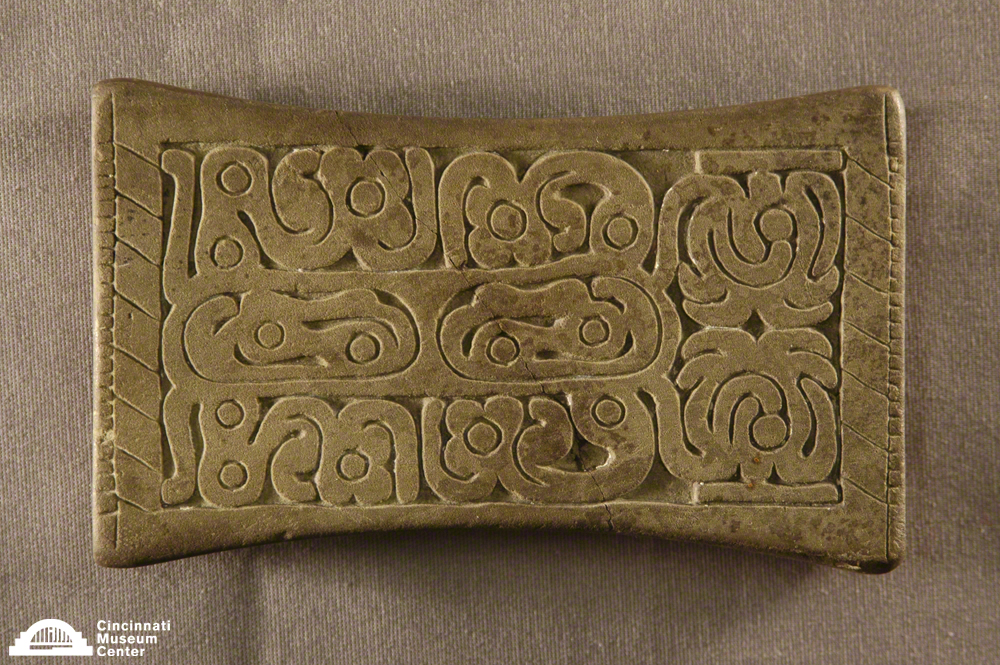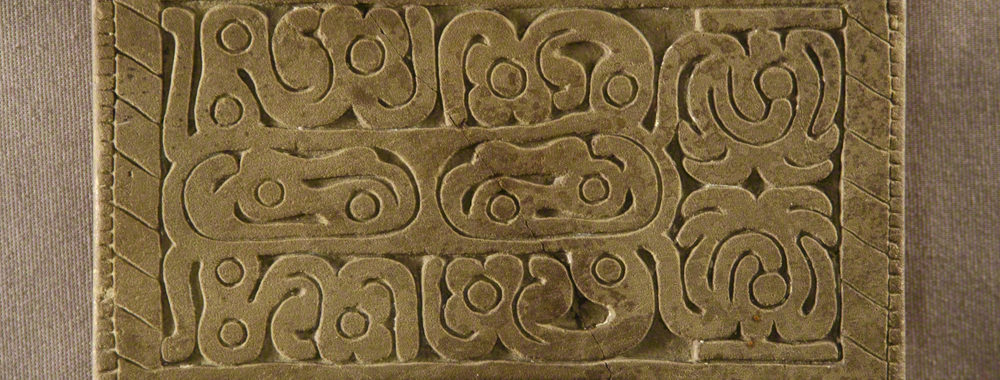
CMC Blog
The Story of the Cincinnati Tablet
By: Tyler Swinney, NAGPRA Coordinator and Tribal Liaison

The Cincinnati Tablet, estimated to be about 2,000 years old, was discovered during 19th-century construction in downtown Cincinnati.
Measuring approximately 5 inches in length, 3 inches in width, and 0.5 inches thick, the Cincinnati Tablet is made from a very fine-grained sandstone and is undoubtedly the most iconic prehistoric artifact yet found in downtown Cincinnati. It was recovered during the fall of 1841 when a grading team was removing a complex of human-made burial mounds near Fifth and Mound Streets, which today is a large UPS facility just west of Interstate 75. While removing the mound complex in preparation for road construction, workers began to uncover numerous exotic artifacts, including thin copper cut-outs, well made lithic tools, galena ore, mica, shell, bone and copper beads, as well as perforated bear canine pendants, large marine shells, and two polished bone awls or perforators.
The discovery of the Cincinnati Tablet quickly drew an enormous amount of interest and was the first “Adena Tablet” described by science. Within a few weeks of its recovery, the Cincinnati Tablet was exhibited at a meeting of the Western Academy of Natural Sciences. Soon thereafter, it was featured in the December 12th, 1842, edition of the Cincinnati Gazette, and was later described in the American Pioneer of May, 1843. A few years later, the Cincinnati Tablet was even featured in Squier and Davis’ famous 1848 publication The Ancient Monuments of the Mississippi Valley, the very first volume of the Smithsonian Contributions to Knowledge. Decades later, interest in the Cincinnati Tablet had not subsided as it was even exhibited in London as part of the 1976 bicentennial tribute to the United States exhibit “Sacred Circles: 2000 Years of North American Indian Art”.
The term “Adena Tablets” refers to a rare type of artifact which has been recovered in contexts that are associated with the Adena culture of the Early Woodland Period (1000-200 B.C.). As many as 13 have been found in Ohio, Kentucky and West Virginia. Tablets are engraved in deep bas-relief and are generally made from fine-grained sandstone, although a few Adena Tablets have been found in other materials, including limestone (Wright tablet), shale (Berlin Tablet) and clay (Gaitskill Tablet 1).
Adena tablets can be engraved on one or both sides and are usually carved with highly stylized zoo-morphs (having the shape of an animal) and curvilinear geometric designs. These are often interpreted as raptorial birds and possibly human shaman motifs dressed in animal regalia and masks. More often than not, images are split down the middle of the stylized geometric designs, perhaps placing a heightened importance on bilateral symmetry.
So far the exact use for the mysterious Adena Tablets is unknown. However, a few have been found with red ochre residue (mineral used to manufacture paint and dye) on stylized surfaces. This leads some archaeologists to believe that the tablets could have been used as stamps for body or fabric decoration. It may also be that the tablets were used for other purposes such as imprinting on pottery or as stenciling aides for tattooing. Several tablets—Cincinnati Tablet included—also have deep grooves opposite the side with curvilinear geometric engravings, which some archaeologists interpret as grooves for sharpening bone awls or needles. The sharpened bone implements could then be used in conjunction with the curvilinear designs to tattoo the designs onto the body permanently.
Museum Admission
Includes Cincinnati History Museum, Museum of Natural History & Science and The Children's Museum
| Adult: | $22.50 |
| Senior: | $15.50 |
| Child: | $15.50 |
| Member Adult: |
FREE |
| Member Child: |
FREE |
Members receive discounts!
Become a Member today to save on programs, exhibits and films throughout CMC.
Museum Hours
Open Thursday – Monday
10 a.m. to 5 p.m.
Closed Tuesday and Wednesday
Closed Thanksgiving Day and Christmas Day
Member’s-only early entry: Saturdays at 9 a.m.
Customer Service Hours:
Monday – Sunday, 9 a.m. to 5 p.m.


